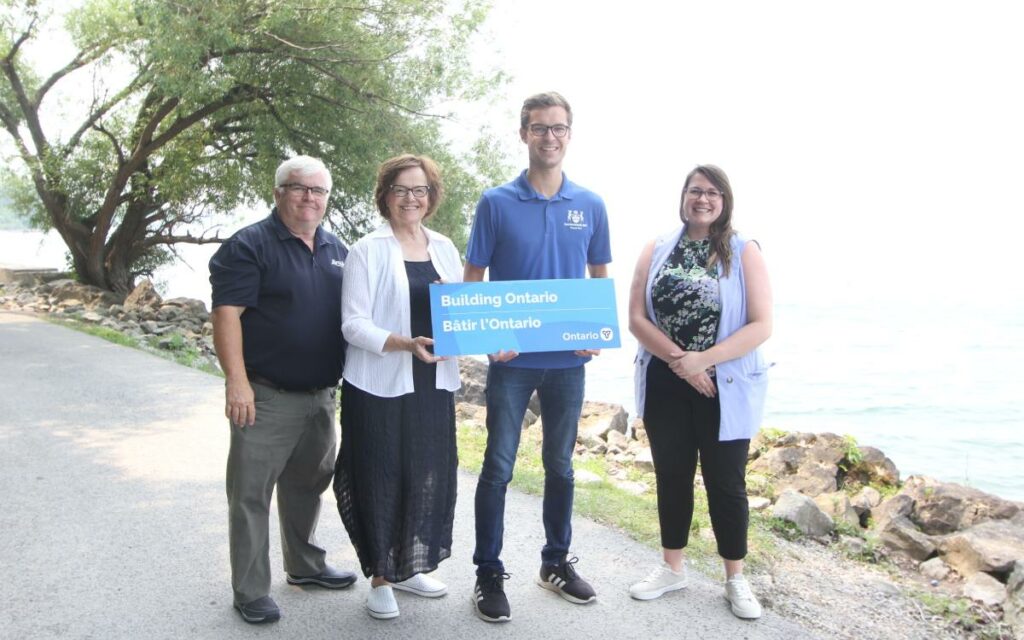
Pictured left to right are Niagara Peninsula Conservation Authority Chair and Lincoln Regional Councillor Rob Foster, Mayor of Lincoln Sandra Easton, MPP for Niagara West Sam Oosterhoff, and Coastal Science Coordinator for Niagara Coastal Community Collaborative Kiersten McCutcheon. Photo credit: Sam Oosterhoff
The Ontario government is investing $6 million to support 30 multi-year projects that will help protect, conserve, and restore the Great Lakes, including two shoreline projects in Niagara.
The investments will help reduce plastic litter and control excess nutrients and road salt entering lakes, rivers, and streams.
The various projects are led by community groups, not-for profits, conservation authorities, universities, Indigenous organizations, and communities across the province and support commitments in the Canada-Ontario Agreement on Great Lakes Water Quality and Ecosystem Health and Ontario’s Great Lakes Strategy.
“Our government is supporting two local important projects to help address environmental challenges facing our local shorelines and deliver projects that help protect, conserve and restore our Great Lakes resources,” said MPP for Niagara West Sam Oosterhoff.
“I applaud the Niagara Peninsula Conservation Authority and Niagara Coastal for working to build a healthy and resilient coastal ecosystem on both shorelines of Lake Erie and Lake Ontario and the banks of the Niagara River.”
The Niagara Peninsula Conservation Authority (NPCA) will use the provincial dollars to conduct studies and develop a plan to clean-up contaminated sediment in a tributary of the Niagara River, engage the community in decision-making related to habitat restoration goals, and provide students and teachers with educational opportunities to learn about the Great Lakes.
“The (NPCA) is committed to be a strong on-the ground delivery partner for commitments made by the provincial and federal governments related to the Canada-U.S. Great Lakes Water Quality Agreement and Canada-Ontario Agreement on Great Lakes Water Quality and Ecosystem Health (COA) currently implemented through the Niagara River Remedial Action Plan and its associated ecosystems improvement projects,” said NPCA Chair Rob Foster.
“We thank the provincial government for their ongoing commitment and support for this program to ensure the Great Lakes are healthy for years to come.”
Niagara Coastal will use the recently announced funds to expand a web platform that engages coastal citizens, community groups, and local organizations in collecting data to fill knowledge gaps for Great Lakes shorelines, including the Niagara River Area of Concern.
“As a shared community resource, it will take a community of people passionate about protecting the Great Lakes and our coastal ecosystems to ensure they can continue to meet our needs and adapt to changing climate conditions,” said Coastal Science Coordinator at Niagara Coastal Kiersten McCutcheon.
“The Visual Assessment Survey Tool (VAST) empowers coastal citizens, community groups and local organizations to become active participants in the protection of their shorelines by collecting data to help guide coastal management decisions and local action,” explained McCutcheon. “The provincial funds have allowed Niagara Coastal to expand the tool to continue monitoring coastal issues and public health and safety concerns across Niagara and the broader Great Lakes region.”
Funding for the Great Lakes Program is part of the Ontario government’s $14 million in annual investments to further protect, conserve, and restore the health of the Great Lakes and support the well-being of communities, like Niagara, that rely on them.
Since 2018, the province has invested $66.5 million in 552 projects to safeguard the Great Lakes.




















